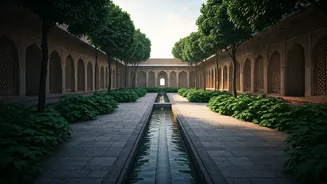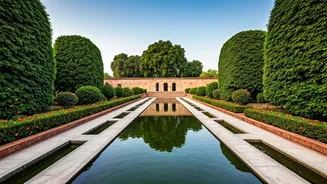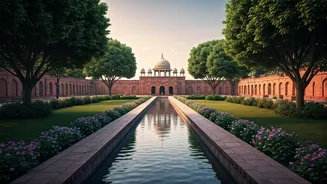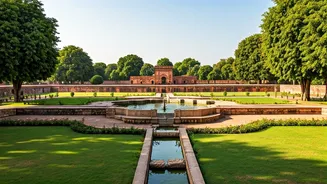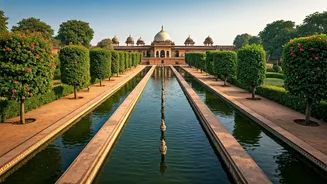Garden's Historical Echoes
Mughal gardens, a significant feature of India's architectural heritage, are known for their distinctive style influenced by Persian gardens. These gardens typically
incorporate elements like charbagh layouts, water features, and symmetrical designs, creating a harmonious blend of nature and art. Historically, Mughal emperors like Babur, Humayun, and Shah Jahan played a vital role in popularizing this garden style across the Indian subcontinent. Their love for nature and their desire to create spaces of tranquility led to the construction of these elaborate gardens, which served as both recreational areas and symbols of imperial power. These gardens not only displayed the rulers' wealth and status but also showcased their refined taste and appreciation for aesthetics. Many Mughal gardens also became crucial locations for royal gatherings, festivals, and celebrations, becoming vibrant centers of cultural and social life. The longevity of these gardens speaks volumes about the Mughal’s sophisticated understanding of landscape design and their commitment to preserving beauty.
Shalimar Bagh, Srinagar
Shalimar Bagh, a testament to Mughal artistry, is situated in Srinagar, Jammu and Kashmir. Built by Emperor Jahangir for his wife Nur Jahan in 1619, the garden is a remarkable display of symmetrical design and water features. Its terraced layout is a signature characteristic, with cascading fountains and channels creating a soothing ambiance. The garden has four terraces, each with its distinct purpose, including public areas, private gardens, and the women's quarters. Chinar trees and flowering plants are carefully arranged to provide shade and visual appeal throughout the seasons. The garden's strategic location along the Dal Lake adds to its scenic beauty, making it a favored spot for visitors. Shalimar Bagh provides insights into the Mughal emperors' interest in creating spaces of serenity, as well as their aesthetic sensibility, making it an enduring attraction for both locals and tourists.
Nishat Bagh: Paradise Garden
Nishat Bagh, meaning 'Garden of Bliss', is another gem in Srinagar, Jammu and Kashmir, established by Asaf Khan, Nur Jahan's brother, in 1633. The garden, situated on the banks of the Dal Lake, presents a panoramic view of the lake and the surrounding mountains. It features a unique design with a series of terraces that descend toward the lake, providing a varied experience of landscape and perspective. The garden’s layout emphasizes the strategic use of water channels, fountains, and flowerbeds to create a visual harmony. The arrangement of the trees, mainly chinar, adds to the garden's allure, providing shade and visual interest throughout the changing seasons. The carefully planned design, combined with the natural beauty of its setting, makes Nishat Bagh a prominent example of the Mughal garden concept, showcasing an excellent example of aesthetics and landscape planning.
The Gardens of Agra
Agra boasts several Mughal gardens, each with unique features that highlight the dynasty's architectural prowess. The Mehtab Bagh, situated across the Yamuna River from the Taj Mahal, offers an excellent vantage point to view this iconic monument, especially during sunrise and sunset. Its restored layout embodies a symmetrical design. The Ram Bagh, often considered the oldest Mughal garden in India, provides a glimpse into the initial stages of Mughal garden design, with its simple yet effective arrangements. These gardens are integral to the cultural tapestry of Agra. The careful design of these gardens reflects the Mughals' vision of creating serene environments that complement the magnificent structures around them. Each garden in Agra gives a unique experience, offering a look at the historical past, while displaying architectural brilliance and refined planning.
Humayun's Tomb Garden
The garden surrounding Humayun's Tomb in Delhi is a significant example of the charbagh style, the classic symmetrical layout prevalent in Mughal gardens. This garden, developed in the 16th century, displays a well-organized division into four main sections, with water channels and walkways that intersect and create a network of visual elements. The garden’s design is not only visually appealing but also symbolic, representing paradise. It includes carefully planted trees, floral arrangements, and fountains to enhance the overall ambiance, providing a balance of tranquility and aesthetic pleasure. The Humayun's Tomb Garden offers an immersive experience, illustrating the integration of architectural design with natural features. The use of water features, like the numerous water channels, adds to the serene environment, making it a peaceful and reflective space. The design reflects the Mughal emperors' love for creating spaces that seamlessly combine architectural brilliance with natural surroundings.
Pinjore Garden's Beauty
The Pinjore Garden, also known as Yadavindra Garden, is located in the Panchkula district of Haryana. This garden reflects a distinct Mughal architectural style combined with regional influences. Its design involves a series of terraces, each featuring elaborate water channels, fountains, and carefully arranged flowerbeds. The garden’s layout follows the traditional charbagh pattern, providing a symmetrical and balanced aesthetic. The architecture also incorporates elements of the local environment, such as the surrounding hills and seasonal changes, which are integrated into the garden’s overall design. The play of light and shadow, the sounds of water, and the natural beauty of the area blend to make a serene and enjoyable environment for visitors. Pinjore Garden is an impressive example of Mughal garden design and the integration of local characteristics, demonstrating a balanced mix of architectural features and natural beauty.
Fatehpur Sikri's Gardens
The city of Fatehpur Sikri, built by Emperor Akbar, features multiple gardens that showcase Mughal garden design. These gardens, though smaller in scale than some others, are important in illustrating the architectural vision of the era. The gardens in Fatehpur Sikri utilize geometric layouts, water features, and carefully selected plant arrangements. The design demonstrates a balance between functionality and aesthetics, with open spaces to facilitate social gatherings and shaded areas. They demonstrate the importance of the garden as a part of the imperial complex, providing recreation and improving the palace's aesthetics. The gardens’ placement inside the palace walls illustrates how the Mughals integrated nature into their lives, offering both visual beauty and functionality, creating calm and welcoming spaces that reflected the era's sophisticated design standards and the rulers' refined tastes.
Taj Mahal Garden
The garden surrounding the Taj Mahal, situated in Agra, is an integral aspect of this iconic monument’s beauty. This garden is a prime example of the charbagh design. It is divided into four main sections, with a central reflecting pool that reflects the mausoleum's grandeur. The garden's layout is symmetrical, with pathways, water channels, and an array of trees and plants carefully chosen to enhance the visual appeal. The design offers a perfect backdrop, emphasizing the architectural brilliance of the Taj Mahal. The gardens' careful planting and maintenance reflect the importance of creating a beautiful environment for the monument. The garden around the Taj Mahal is not only visually stunning but also has deep historical significance, reflecting the Mughal emperors' appreciation for art, design, and their dedication to building monuments of lasting beauty.
Lodi Garden, Delhi
Lodi Garden in Delhi, while influenced by Mughal design, incorporates elements of various styles, showcasing a unique blend of cultures. The garden features historic tombs and structures, which add to its historical depth. The layout includes walkways, green spaces, and water features that are arranged to create an environment of peace. Its design has evolved over time, reflecting changes in aesthetics and the use of the area. Lodi Garden offers a green retreat within the city, providing a serene space where people can relax and appreciate the historical and natural environment. The combination of historical structures, green spaces, and water elements demonstrates a different approach to garden design, providing a space that is both visually captivating and historically important.
Garden Legacy's Influence
The impact of Mughal gardens is apparent in modern landscape design, inspiring architects, designers, and enthusiasts worldwide. Mughal garden features such as symmetrical layouts, water elements, and the use of plants continue to influence the aesthetics of gardens and public spaces. Many contemporary gardens include Mughal design components, demonstrating the everlasting allure of this design style. These gardens set a new standard for landscape architecture. Moreover, their lasting appeal showcases how Mughal emperors valued architectural brilliance, artistic flair, and the harmony of nature. Their influence can be seen in modern landscape projects. The Mughal design continues to provide a sense of peace, beauty, and cultural history to the world, reminding us of the era's rich artistic traditions.
